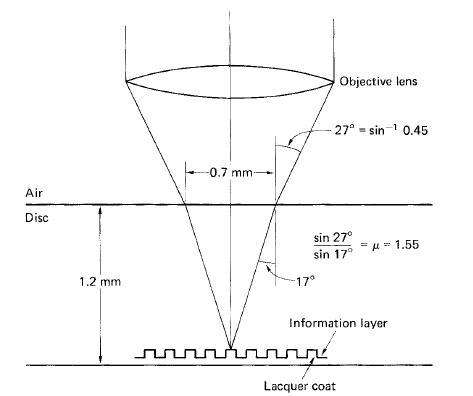Look at the image above. The objective lens of a CD pickup has a numerical aperture (NA) of 0.45; thus the outermost rays will be inclined at approximately 27 degrees to the normal. Refraction at the air/disk interface changes this to approximately 17 degrees within the disk. Thus light focused to a spot on the information layer has entered the disk through a 0.7mm diameter circle, giving good resistance to surface contamination.
A fundamental goal of consumer optical disks is that no special working environment or handling skill is required. The bandwidth needed by PCM audio is such that high-density recording is mandatory if reasonable playing time is to be obtained in CD. High-density recording implies short wavelengths. Using a laser focused on the disk from a distance allows short-wavelength recordings to be played back without physical contact, whereas conventional magnetic recording requires intimate contact and implies a wear
The information layer of CD is read through the thickness of the disk. The figure above shows that this approach causes the readout beam to enter and leave the disk surface through the largest possible area. The actual dimensions involved are shown in the figure. Despite the minute spot size of about 1.2micro millimeter diameter, light enters and leaves through a 0.7 mm-diameter circle. As a result, surface debris has to be three orders of magnitude larger than the readout spot before the beam is obscured.
The size of the entry circle is a function of the refractive index of the disk material, the numerical aperture of the objective lens and the thickness of the disk. CDs have no protection, but fortunately the method of readout through the disk thickness tolerates surface scratches very well. In extreme cases of damage, a scratch can often successfully be removed with metal polish. By way of contrast, the label side is actually more vulnerable than the readout side, since the lacquer coating is only 30micro mm thick. For this reason, writing on the label side of CD is not recommended. Pressure from a pen could distort the information layer, and solvents from marker pens have been known to penetrate the lacquer and cause corruption. The common party-piece of writing on the readout surface of CD with a felt pen to show off the error correction system is quite harmless, since the disk base material is impervious to most solvents.
That was the good side. Now let us understand the bad side.
Remember that the CD is a mechanical device. The 'land' and 'pit' are physical variants just below the surface that reflect the light in different intensities. The amount of recflected light determines the ones and zeros. Given the minute amount of differences we are talking about, the error correction mechanism has a tough job to do.
Most laser assemblies are allowed to pivot in order to keep the laser beam in contact with the spiral data track. The high speed of rotation and the movement of the laser head can cause resonances that shift the laser head. When this happens, the data read will be incorrect leading to jitters and errors. A laser's direct hit on a 'pit' will most likely allow the laser to read the pit correctly. While error correction can extrapolate and fill in the missing data, better tracking will mean lesser errors leading to lesser error correction and better sound.
Sources and Acknowledgements
1. Stereophile
2.
The Art Of Digital Audio by John Watkinson
Cheers


